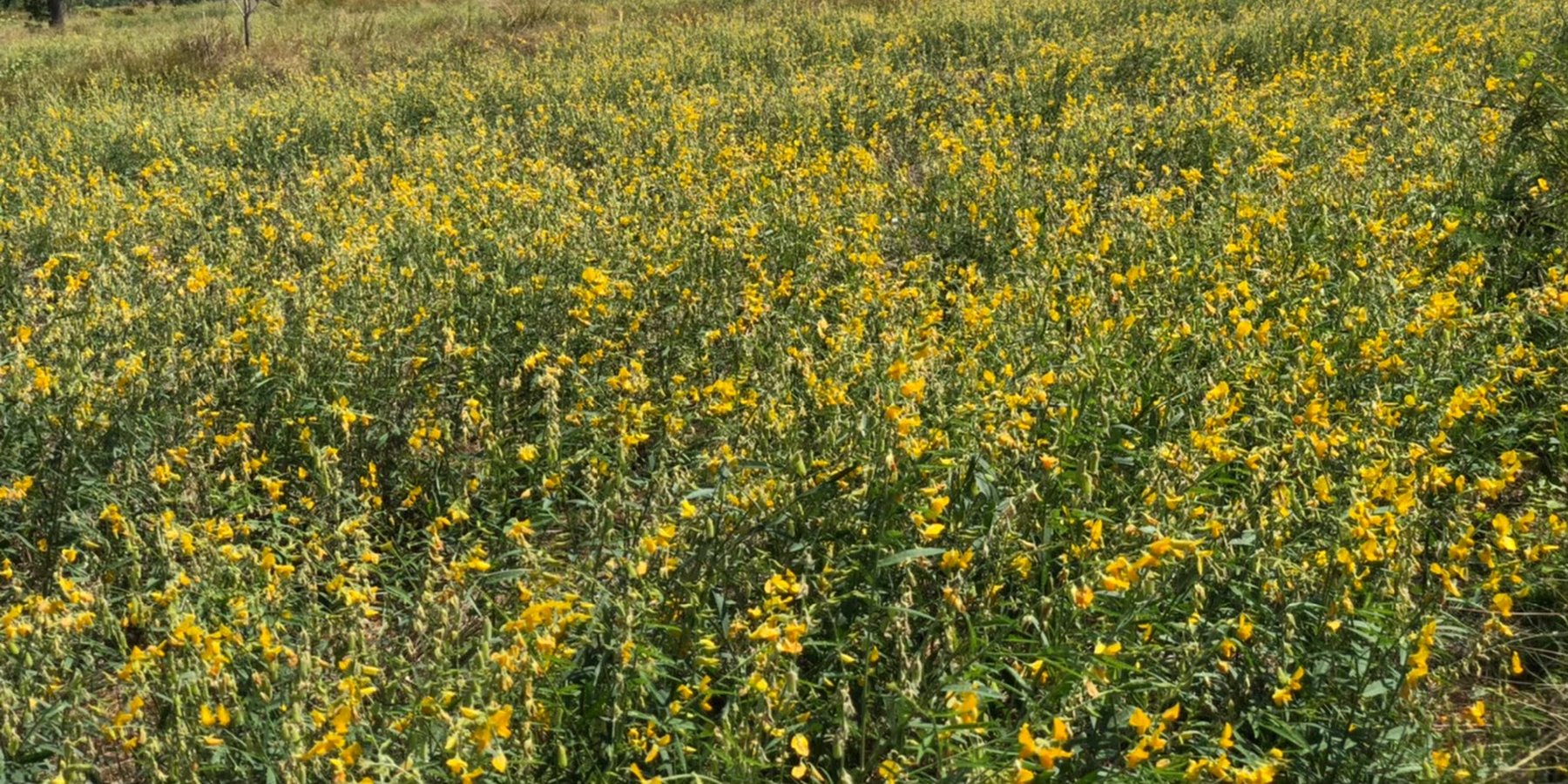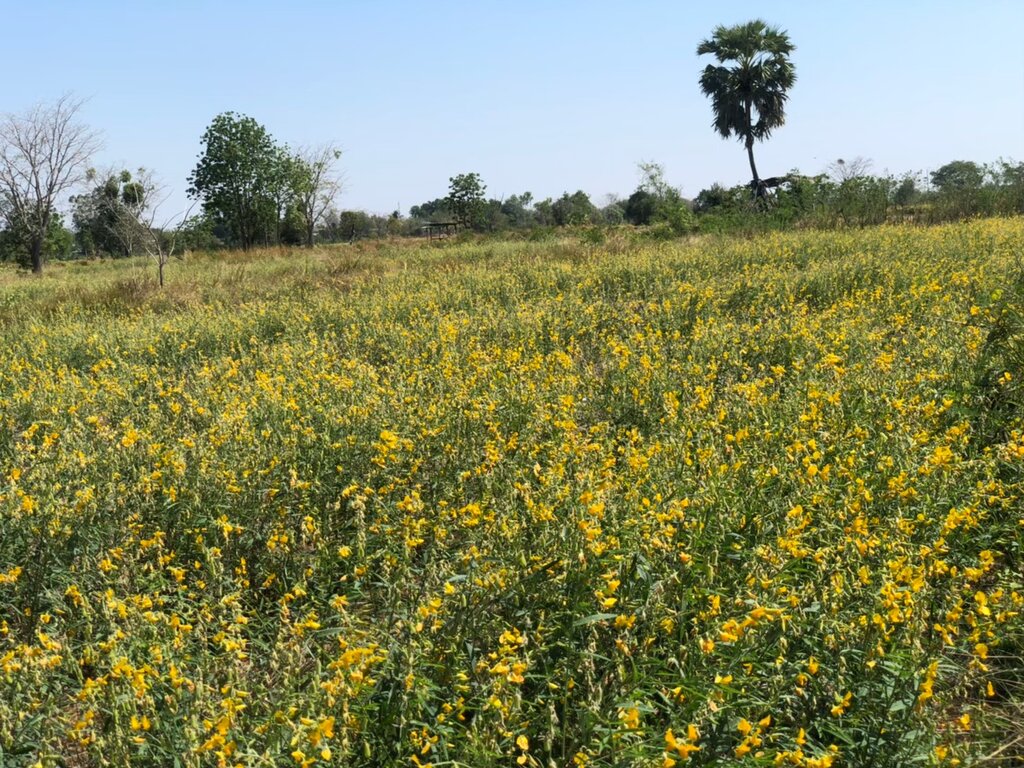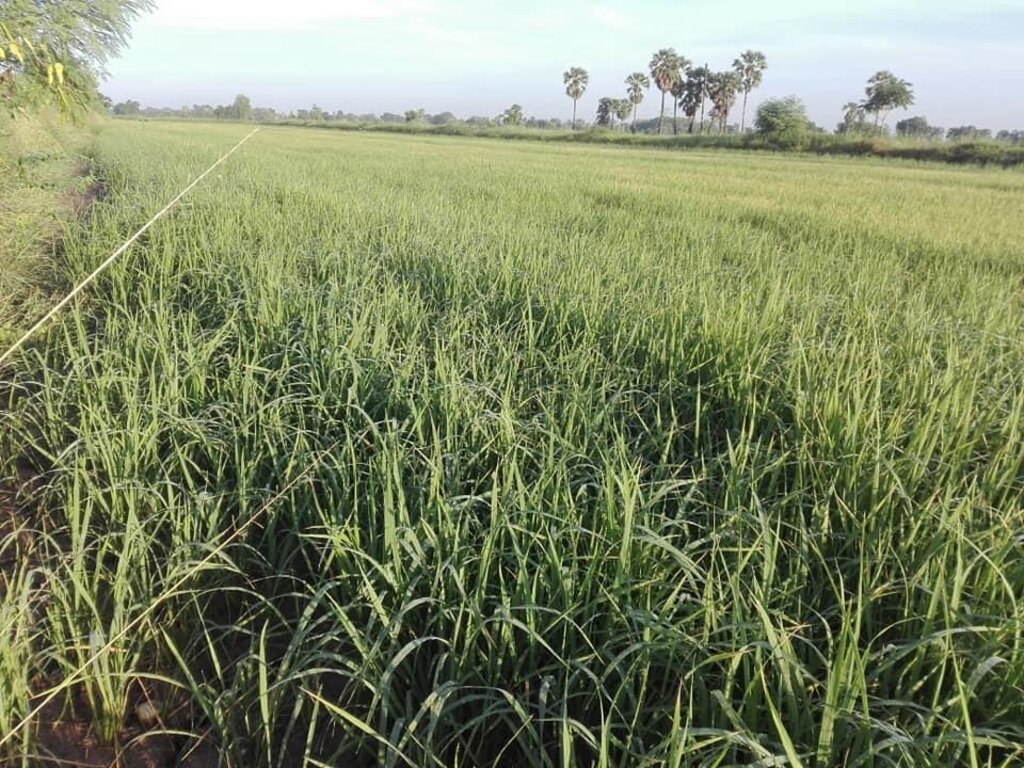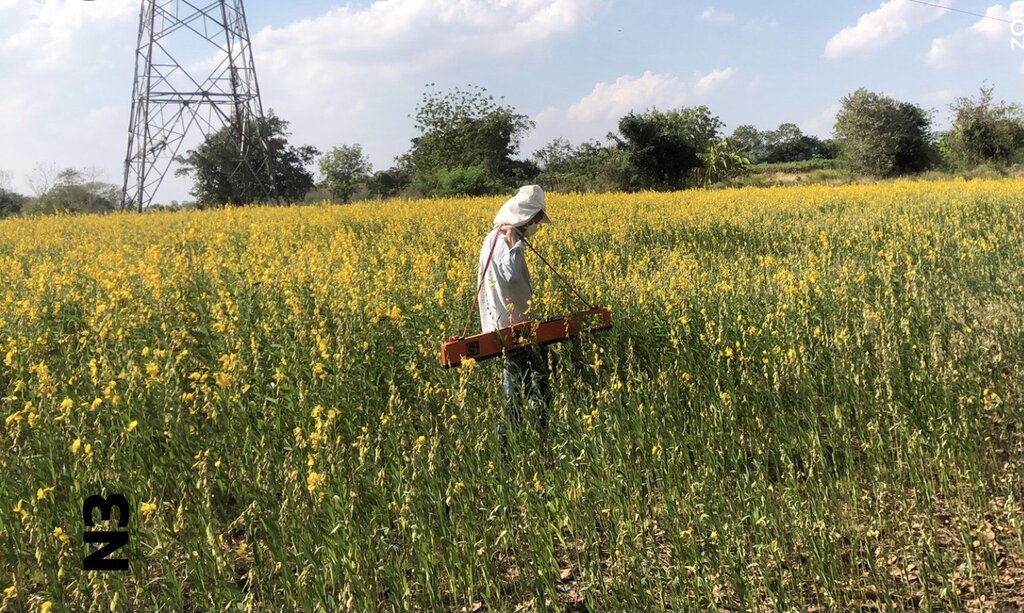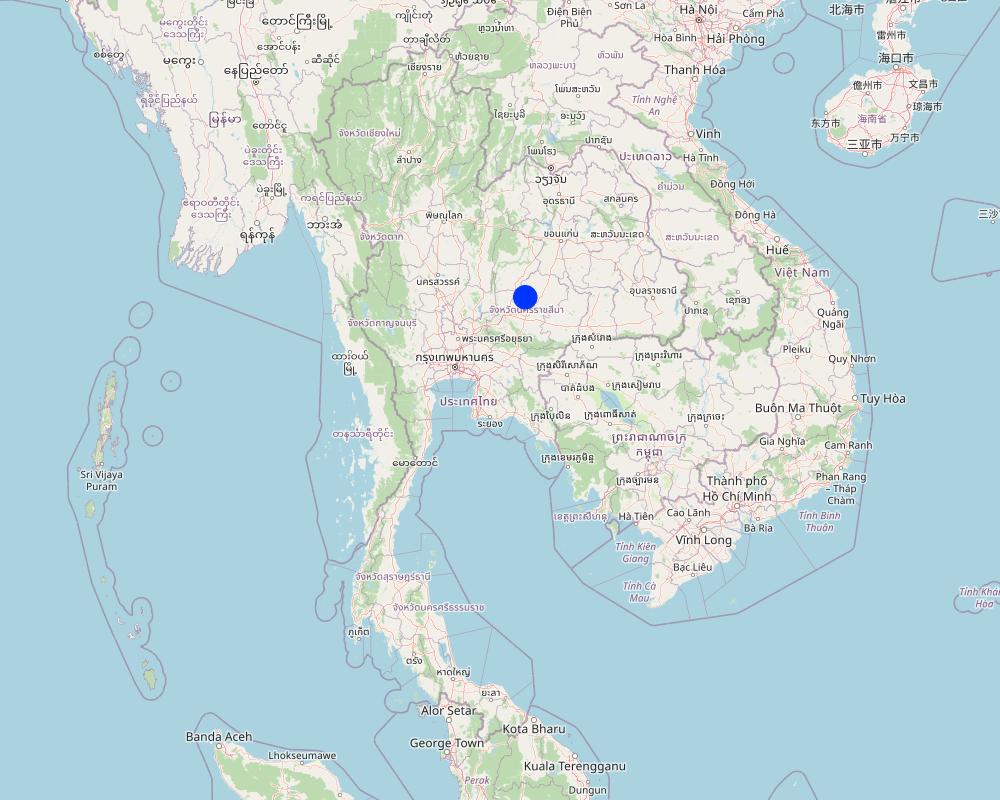GREEN MANURE: AN AMAZING CROP FOR SOIL AMENDMENT AND SALINE SOIL REDUCTION OF THE NORTHEST OF THAILAND (I-SAN) [ไทย]
- ผู้สร้างสรรค์:
- การอัพเดท:
- ผู้รวบรวม: Laksamee Mettpranee
- ผู้เรียบเรียง: –
- ผู้ตรวจสอบ: William Critchley, Rima Mekdaschi Studer, Joana Eichenberger
technologies_7274 - ไทย
ดูส่วนย่อย
ขยายทั้งหมด ย่อทั้งหมด1. ข้อมูลทั่วไป
1.2 รายละเอียดที่ติดต่อได้ของผู้รวบรวมและองค์กรที่เกี่ยวข้องในการประเมินและการจัดเตรียมทำเอกสารของเทคโนโลยี
วิทยากรหลัก
ผู้ใช้ที่ดิน:
Siangsunthia Mana
ไทย
Compiler:
co-compiler:
Raksasarp Pithcanun
Land Development Department
ไทย
co-compiler:
reviewer:
reviewer:
ชื่อของโครงการซึ่งอำนวยความสะดวกในการทำเอกสารหรือการประเมินเทคโนโลยี (ถ้าเกี่ยวข้อง)
Decision Support for Mainstreaming and Scaling out Sustainable Land Management (GEF-FAO / DS-SLM)ชื่อขององค์กรซึ่งอำนวยความสะดวกในการทำเอกสารหรือการประเมินเทคโนโลยี (ถ้าเกี่ยวข้อง)
Land Development Department (Land Development Department) - ไทยชื่อขององค์กรซึ่งอำนวยความสะดวกในการทำเอกสารหรือการประเมินเทคโนโลยี (ถ้าเกี่ยวข้อง)
Centre of Excellence for Soil Research in Asia (CESRA)1.3 เงื่อนไขการใช้ข้อมูลที่ได้บันทึกผ่านทาง WOCAT
ผู้รวบรวมและวิทยากรหลักยอมรับเงื่อนไขเกี่ยวกับการใช้ข้อมูลที่ถูกบันทึกผ่านทาง WOCAT:
ใช่
1.4 การเปิดเผยเรื่องความยั่งยืนของเทคโนโลยีที่ได้อธิบายไว้
เทคโนโลยีที่ได้อธิบายไว้นี้เป็นปัญหาของความเสื่อมโทรมโทรมของที่ดินหรือไม่ จึงไม่ได้รับการยอมรับว่าเป็นเทคโนโลยีเพื่อการจัดการที่ดินอย่างยั่งยืน:
ไม่ใช่
แสดงความคิดเห็น:
Farmers in Non Thai Subdistrict, Non Thai District, Nakhon Ratchasima Province, have historically improved soil quality, enabling them to cultivate rice and reduce production costs in areas with slightly saline soil. By using green manure crops like sun hemp (Crotalaria juncea) as a rotational crop and plowing it back into the soil, they have increased organic matter and plant nutrients in the long term, making them sufficient for plant uptake."
1.5 Reference to Questionnaire(s) on SLM Approaches (documented using WOCAT)
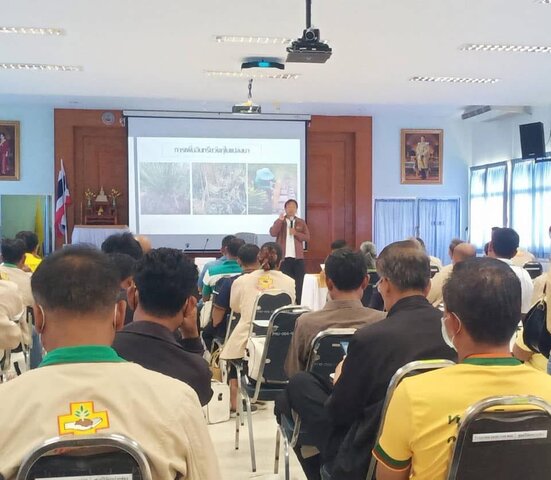
EXTENSION OF USING THE GREEN MANURE PLANT (SUNN. … [ไทย]
Green manure crops are materials for saline soil amendment suitably to increase organic matter and nitrogen to soil. This is because they are cheap when compared with using other types of organic fertilizer.
- ผู้รวบรวม: Laksamee Mettpranee
2. การอธิบายลักษณะของเทคโนโลยี SLM
2.1 การอธิบายแบบสั้น ๆ ของเทคโนโลยี
คำจำกัดความของเทคโนโลยี:
Land Development Department also promoted using Crotalaria juncea (sunn hemp) as a green manure plant with the objective to increase organic matter and improve soil. Moreover, planting and storing seeds can be done more easily than other green manure.
2.2 การอธิบายแบบละเอียดของเทคโนโลยี
คำอธิบาย:
The Northeast of Thailand covers the area of 17.12 million ha. This region has the most area of rice farming in the country. However, the ratio of yields per hectare is still low when compared with other regions. It must rely on rain water whereby the amount of rain distribution is not constant. Soil fertility is low. The organic matter in soil is decreased rapidly due to poor texture soil. Another 17% of the area consists of saline soils. A method of maintaining the fertility level of soil, this is to the increase of crop yield under the saline soil by increasing organic matter and plant nutrients in soil, especially nitrogen nutrition in soil. Due to the fact that nitrogen fertilizers currently costs so expensive, Land Development Department, Ministry of Agriculture and cooperatives, has the project of soil amendment with green manure plants (Crotalaria juncea) and the campaign project of plowing up and over to cover straw stubble and green manure plants for soil amendment to reduce global warming in every area of Thailand from the area of farmers growing rice. This area also has limitations from land use which are having saline soil with a slight salinity to moderate salinity, low organic matter and low fertility and pH values in soil with a slight acidity and alkalinity. In the area of Non Thai district, Nakhon Ratchasima province, it faces the problem of water shortage in the dry season. The area is also outside the irrigation zone. Farmerss and officers of Land Development Department have transferred knowledge regarding increasing organic matter in the areas with degraded soils whereby volunteer soil doctors and farmers in the area implement the technology including applying it together with soil and water conservation in cultivation areas.
Mr. Mana Siangsunthia, volunteer soil doctor of Non Thai district, Nakhon Ratchasima province, is a farmer who understands, reaches and is ready to learn problem solving in his own area made use for occupation by having cooperated with officers of Area 3 Land Development Office, Land Development Department since 1997 in receiving supports such as production factors, PD microorganisms, green manure plants, vetiver and water resources in the paddy field. Moreover, guidelines obtained from learning are implemented to develop his own area where the Khaw Dawk mali 105 rice variety is grown accounting for 1.12 ha. Previously, any plants grown in the mentioned area could not produce any yields. Due to problems of degraded soils used in cultivating industrial crops for a long time, the soils have been degraded chemically and physically with low fertility. Soil texture is characterized by being sandy clay loam. Flaky salt stain was found on the soil surface and the soil is saline with lack of water in the dry season. As a result, a snag occurs. This also includes the fact that the area is outside the irrigation zone, making farmers unable to cultivate rice and obtain yields as needed. As a result, household incomes are low. Therefore, knowledge of using green manure plants has been implemented in the area with saline soils for growing rice together with using fermented bio-extracts from banana shoots and chemical fertilizers application according to advice. In 2004, average yields of 1,125-1,563 kg/ha were obtained. This had been practiced continuously until 2011. Rice yields increased to 2,500 kg/ha
After having used Crotalaria juncea (Sunn hemp) for 16 years continuously, the soil has had better structures, becoming incoherent. Salinity of the soil has been reduced. This has brought about the origin of conducting farming based on natural agriculture restoring areas with saline soil without using chemical fertilizers from 2013 to the present time. Farmers also use the technique of observing weather conditions together with water management to be sufficient during having a dry spell due to climate variability. The green manure plant " Crotalaria juncea (Sunn hemp)" is used at the rate of 31.25 kg/ha for soil amendment for every 2 years together with selection of salt tolerance Kow Hom Thai rice varieties with outstanding characteristics of tolerating drought and pests well. As a result, yields of 3,125-3,750 kg/ha were obtained.
During the dry season after harvesting yields, in order to keep moisture in the soil, the method of plowing up and over to cover straw and stubble is used. They are not burned. The ground is covered with leaf debris. Crotalaria juncea (sunn hemp) is sowed during the harvesting season and it is allowed to fall naturally without plowing up an over during the flowering period. Fermented bio-extracts are used after harvesting. Soil and water conservation is focused in the cultivation area. During the rainy season, if rain water is at a high enough amount, it can be stored to be used in the dry season. Apart from this, farmers can also use the technique of washing off salt from the soil surface into water resources. There has been improvement of water quality with fermented bio-extracts at the rate of about 40 liters per cubic meters to be used for cultivation in the dry season.
2.3 รูปภาพของเทคโนโลยี
2.5 ประเทศภูมิภาค หรือสถานที่ตั้งที่เทคโนโลยีได้นำไปใช้และได้รับการครอบคลุมโดยการประเมินนี้
ประเทศ:
ไทย
ภูมิภาค/รัฐ/จังหวัด:
Nakhonratchasima
ข้อมูลจำเพาะเพิ่มเติมของสถานที่ตั้ง :
Moo 5, Ban Kok Phrom, Non Thai sub-district, Non Thai district
ระบุการกระจายตัวของเทคโนโลยี:
- กระจายไปอย่างสม่ำเสมอในพื้นที่
If the Technology is evenly spread over an area, specify area covered (in km2):
11200.0
Is/are the technology site(s) located in a permanently protected area?
ไม่ใช่
Map
×2.6 วันที่การดำเนินการ
ระบุปีที่ใช้:
1999
ถ้าไม่รู้ปีที่แน่นอน ให้ระบุวันที่โดยประมาณ:
- 10-50 ปี
2.7 คำแนะนำของเทคโนโลยี
ให้ระบุว่าเทคโนโลยีถูกแนะนำเข้ามาอย่างไร:
- ด้วยการริเริ่มของผู้ใช้ที่ดินเอง
- ทางโครงการหรือจากภายนอก
ความคิดเห็น (ประเภทของโครงการ เป็นต้น) :
The technology arises from land users’ innovation and is supported by external interventions and government agencies that acknowledge the value of technology to the community by providing resources, funding and supporting research and development.
3. การจัดประเภทของเทคโนโลยี SLM
3.1 วัตถุประสงค์หลักของเทคโนโลยี
- ปรับปรุงการผลิตให้ดีขึ้น
- ลด ป้องกัน ฟื้นฟู การเสื่อมโทรมของที่ดิน
- อนุรักษ์ระบบนิเวศน์
- รักษาสภาพหรือปรับปรุงความหลากหลายทางชีวภาพ
- สร้างผลกระทบทางด้านเศรษฐกิจที่เป็นประโยชน์
3.2 ประเภทของการใช้ที่ดินในปัจจุบันที่ได้นำเทคโนโลยีไปใช้
Land use mixed within the same land unit:
ไม่ใช่

พื้นที่ปลูกพืช
- การปลูกพืชล้มลุกอายุปีเดียว
- sunhemp - rice
จำนวนของฤดูเพาะปลูกต่อปี:
- 1
Is intercropping practiced?
ไม่ใช่
Is crop rotation practiced?
ใช่
ถ้าใช่ ระบุ:
Rice and sunn hemp
3.3 Has land use changed due to the implementation of the Technology?
Has land use changed due to the implementation of the Technology?
- Yes (Please fill out the questions below with regard to the land use before implementation of the Technology)
Land use mixed within the same land unit:
ไม่ใช่

พื้นที่ปลูกพืช
- การปลูกพืชล้มลุกอายุปีเดียว
- sunhemp-rice
Is intercropping practiced?
ไม่ใช่
Is crop rotation practiced?
ไม่ใช่
3.4 การใช้น้ำ
การใช้น้ำของที่ดินที่มีการใช้เทคโนโลยีอยู่:
- น้ำฝนร่วมกับการชลประทาน
แสดงความคิดเห็น:
Rainfed lowland rice can be supported by small ponds for irrigation.
3.5 กลุ่ม SLM ที่ตรงกับเทคโนโลยีนี้
- การปรับปรุงดิน / พืชคลุมดิน
- การจัดการความอุดมสมบรูณ์ของดินแบบผสมผสาน
3.6 มาตรการ SLM ที่ประกอบกันเป็นเทคโนโลยี

มาตรการจัดการพืช
- A1: พืช/สิ่งปกคลุมดิน
- A2: อินทรียวัตถุในดิน/ความอุดมสมบูรณ์ในดิน
3.7 รูปแบบหลักของการเสื่อมโทรมของที่ดินที่ได้รับการแก้ไขโดยเทคโนโลยี

การเสื่อมโทรมของดินทางด้านเคมี
- Cs (Salinization/alkalinization): การสะสมเกลือหรือการทำให้เป็นด่าง

การเสื่อมโทรมของดินทางด้านชีวภาพ
- Bc (Reduction of vegetation cover): การลดลงของจำนวนพืชที่ปกคลุมดิน
- Bs (Quality and species composition): องค์ประกอบหรือความหลากหลายทางคุณภาพและชนิดพันธุ์ลดลง
3.8 การป้องกัน การลดลง หรือการฟื้นฟูความเสื่อมโทรมของที่ดิน
ระบุเป้าหมายของเทคโนโลยีกับความเสื่อมโทรมของที่ดิน:
- ป้องกันความเสื่อมโทรมของที่ดิน
- ฟื้นฟูบำบัดที่ดินที่เสื่อมโทรมลงอย่างมาก
แสดงความคิดเห็น:
Sunn hemp (Crotalaria juncea) helps to improve soil fertility, leading to higher rice yields.
Sunn hemp (Crotalaria juncea) helps to improve soil fertility, leading to higher rice yields.
Sunn hemp (Crotalaria juncea) helps to improve soil fertility, leading to higher rice yields.
4. ข้อมูลจำเพาะด้านเทคนิค กิจกรรมการนำไปปฏิบัติใช้ ปัจจัยนำเข้า และค่าใช้จ่าย
4.1 แบบแปลนทางเทคนิคของเทคโนโลยี
ข้อมูลจำเพาะด้านเทคนิค (แบบแปลนทางเทคนิคของเทคโนโลยี):
Above shows irrigation ponds associated with rice production. Below is the annual planting calendar where sunn hemp is used.
ผู้เขียน:
Sirinan Soamjinda
วันที่:
02/08/2020
ข้อมูลจำเพาะด้านเทคนิค (แบบแปลนทางเทคนิคของเทคโนโลยี):
Methods of planting Crotalaria juncea (sunn hemp) to be used as a green manure plant in areas with saline soil are as follows:
1. The period of planting is during February to April whereby planting is conducted in between after harvesting rice yields so that Crotalaria juncea ( Sunn hemp) can thrive and give out high biomass.
2. Plough and ferment rice stubble together with using PD 2 bio-extracts to create bacterial process in the soil accelerating decomposition taking about 2 weeks. Then, sunn hemp is sown at the rate of 31.25 kg/ha in the soil with appropriate moisture throughout the plot in order to bring about regular germination.
3. Plowing up and over to cover sunn hemp stubble at the age of 120 days after collecting seeds of sunn hemp whereby the stem of sunn hemp is at the average of more than 1.2 meters resulting in obtaining more biomass. After that, during the period of preparing the area for planting rice, rice can be sowed in May or when there is enough amount of water.
4. When the seeds are kept to be used in the following season, the seed coat of sunn hemp is used as material incorporated with soil to make compost for soil amendment in growing vegetables.
ผู้เขียน:
Sirinan Soamjinda
วันที่:
02/08/2020
4.2 ข้อมูลทั่วไปเกี่ยวกับการคำนวณปัจจัยนำเข้าและค่าใช้จ่าย
ให้ระบุว่าค่าใช้จ่ายและปัจจัยนำเข้าได้รับการคำนวณอย่างไร:
- ต่อพื้นที่ที่ใช้เทคโนโลยี
ระบุขนาดและหน่วยพื้นที่:
1.12 ha
If using a local area unit, indicate conversion factor to one hectare (e.g. 1 ha = 2.47 acres): 1 ha =:
1 ha=6.25 rai
ระบุสกุลเงินที่ใช้คำนวณค่าใช้จ่าย:
- USD
อื่นๆ หรือสกุลเงินประจำชาติ (ระบุ):
Baht
If relevant, indicate exchange rate from USD to local currency (e.g. 1 USD = 79.9 Brazilian Real): 1 USD =:
34.0
ระบุค่าเฉลี่ยของค่าจ้างในการจ้างแรงงานต่อวัน:
300
4.3 กิจกรรมเพื่อการจัดตั้ง
| กิจกรรม | Timing (season) | |
|---|---|---|
| 1. | planting is conducted in between after harvesting rice yields so that Crotalaria juncea ( Sunn hemp) can thrive and give out high biomass. | The period of planting is during February to April |
| 2. | Plough and ferment rice stubble together with using PD 2 bio-extracts to create bacterial process in the soil accelerating decomposition taking about 2 weeks. Then, sunn hemp is sowed at the rate of 31.25 kg/ha in the soil with appropriate moisture throughout the plot in order to bring about regular germination. | Plough and ferment rice stubble together with using PD 2 bio-extracts to create bacterial process in the soil accelerating decomposition taking about 2 weeks. Then, sunn hemp is sowed at the rate of 31.25 kg/ha in the soil with appropriate moisture throughout the plot in order to bring about regular germination. |
| 3. | Plowing up and over to cover sunn hemp stubble at the age of 120 days after collecting seeds of sunn hemp whereby the stem of sunn hemp is at the average of more than 1.2 meters resulting in obtaining more biomass. After that, during the period of preparing the area for planting rice, rice can be sowed in May or when there is enough amount of water. | May-August |
| 4. | When the seeds are kept to be used in the following season, the seed coat of sunn hemp is used as material incorporated with soil to make compost for soil amendment in growing vegetables. | May-August |
4.4 ค่าใช้จ่ายของปัจจัยนำเข้าที่จำเป็นสำหรับการจัดตั้ง
| ปัจจัยนำเข้า | หน่วย | ปริมาณ | ค่าใช้จ่ายต่อหน่วย | ค่าใช้จ่ายทั้งหมดต่อปัจจัยนำเข้า | %ของค่าใช้จ่ายที่ก่อให้เกิดขึ้นโดยผู้ใช้ที่ดิน | |
|---|---|---|---|---|---|---|
| แรงงาน | Plow to prepare plots | Time | ||||
| แรงงาน | Sow rice | Time | ||||
| แรงงาน | Pump water | Time | ||||
| แรงงาน | Harvest yield | Time | ||||
| วัสดุด้านพืช | Rice seeds | Kilogram | ||||
| ปุ๋ยและสารฆ่า/ยับยั้งการเจริญเติบโตของสิ่งมีชีวิต (ไบโอไซด์) | Weight | Liter | ||||
| ปุ๋ยและสารฆ่า/ยับยั้งการเจริญเติบโตของสิ่งมีชีวิต (ไบโอไซด์) | Green manure | Kilogram | ||||
| อื่น ๆ | Oil costs for farm truck | Time |
ถ้าผู้ใช้ที่ดินรับภาระน้อยกว่า 100% ของค่าใช้จ่าย ให้ระบุว่าใครเป็นผู้รับผิดชอบส่วนที่เหลือ:
Land Development Department
แสดงความคิดเห็น:
Calculation of costs and expenses
Expenses are calculated per areas using technology (Unit of size and area: 1.12 ha)
The currency used to calculate expenses with the unit as Baht
Exchange rate (to US. dollars) 1 US. Dollars = 34.0 Baht
Average wage in hiring labor per day is 8.82 USD
4.5 การบำรุงรักษาสภาพหรือกิจกรรมที่เกิดขึ้นเป็นประจำ
| กิจกรรม | ช่วงระยะเวลา/ความถี่ | |
|---|---|---|
| 1. | No maintenance activities | February-April |
| 2. | Plough and ferment rice stubble together with using PD 2 bio-extracts to create bacterial process in the soil accelerating decomposition taking about 2 weeks. Then, sunn hemp is sowed at the rate of 31.25 kg/ha in the soil with appropriate moisture throughout the plot in order to bring about regular germination. | February-April |
| 3. | Ploughing up and over to cover sunn hemp stubble at the age of 120 days after collecting seeds of sunn hemp whereby the stem of sunn hemp is at the average of more than 1.2 meters resulting in obtaining more biomass. After that, during the period of preparing the area for planting rice, rice can be sowed in May or when there is enough amount of water. | May-August |
| 4. | When the seeds are kept to be used in the following season, the seed coat of sunn hemp is used as material incorporated with soil to make compost for soil amendment in growing vegetables. | May-August |
แสดงความคิดเห็น:
Ban Kok Phrom Village, Non Thai sub-district, Non Thai district, Nakhon Ratchasima province
4.6 ค่าใช้จ่ายของปัจจัยนำเข้าและกิจกรรมที่เกิดขึ้นเป็นประจำที่ต้องการการบำรุงรักษา (ต่อปี)
| ปัจจัยนำเข้า | หน่วย | ปริมาณ | ค่าใช้จ่ายต่อหน่วย | ค่าใช้จ่ายทั้งหมดต่อปัจจัยนำเข้า | %ของค่าใช้จ่ายที่ก่อให้เกิดขึ้นโดยผู้ใช้ที่ดิน | |
|---|---|---|---|---|---|---|
| แรงงาน | No labor cost for maintenance | 0 | 1.0 | 14.71 | 14.71 | 100.0 |
| แรงงาน | Sow rice | Time | 1.0 | 17.65 | 17.65 | 100.0 |
| แรงงาน | Pump water | Time | 2.0 | 58.82 | 117.64 | 100.0 |
| แรงงาน | Harvest yield | Time | 1.0 | 183.82 | 183.82 | 100.0 |
| วัสดุด้านพืช | Rice seeds | Kilogram | 8.0 | 0.53 | 4.24 | 100.0 |
| ปุ๋ยและสารฆ่า/ยับยั้งการเจริญเติบโตของสิ่งมีชีวิต (ไบโอไซด์) | Weight | Liter | 40.0 | 0.29 | 11.6 | 100.0 |
| ปุ๋ยและสารฆ่า/ยับยั้งการเจริญเติบโตของสิ่งมีชีวิต (ไบโอไซด์) | Green Manure | Kilogram | 5.0 | 0.68 | 3.4 | 100.0 |
| อื่น ๆ | Oil costs for farm truck | Time | 1.0 | 58.82 | 58.82 | 100.0 |
| ค่าใช้จ่ายทั้งหมดของการบำรุงรักษาสภาพเทคโนโลยี | 411.88 | |||||
| Total costs for maintenance of the Technology in USD | 12.11 | |||||
ถ้าผู้ใช้ที่ดินรับภาระน้อยกว่า 100% ของค่าใช้จ่าย ให้ระบุว่าใครเป็นผู้รับผิดชอบส่วนที่เหลือ:
The Land Development Department does not provide financial support but instead supports agricultural production inputs, such as green manure seeds and raw materials for compost production.
แสดงความคิดเห็น:
Calculation of costs and expenses
Expenses are calculated per areas using technology (Unit of size and area: 1.12 ha)
The currency used to calculate expenses with the unit as Baht
Exchange rate (to US. dollars) 1 US. Dollars = 34.0 Baht
Average wage in hiring labor per day is 8.82 USD
4.7 ปัจจัยสำคัญที่สุดที่มีผลกระทบต่อค่าใช้จ่าย
ปัจจัยสำคัญที่สุดที่มีผลกระทบต่อค่าใช้จ่ายต่างๆ:
1. Labor costs
2. Fuel costs
5. สิ่งแวดล้อมทางธรรมชาติและของมนุษย์
5.1 ภูมิอากาศ
ฝนประจำปี
- < 250 ม.ม.
- 251-500 ม.ม.
- 501-750 ม.ม.
- 751-1,000 ม.ม.
- 1,001-1,500 ม.ม.
- 1,501-2,000 ม.ม.
- 2,001-3,000 ม.ม.
- 3,001-4,000 ม.ม.
- > 4,000 ม.ม.
เขตภูมิอากาศเกษตร
- กึ่งชุ่มชื้น
5.2 สภาพภูมิประเทศ
ค่าเฉลี่ยความลาดชัน:
- ราบเรียบ (0-2%)
- ลาดที่ไม่ชัน (3-5%)
- ปานกลาง (6-10%)
- เป็นลูกคลื่น (11-15%)
- เป็นเนิน (16-30%)
- ชัน (31-60%)
- ชันมาก (>60%)
ธรณีสัณฐาน:
- ที่ราบสูง/ที่ราบ
- สันเขา
- ไหล่เขา
- ไหล่เนินเขา
- ตีนเนิน
- หุบเขา
ระดับความสูง:
- 0-100 เมตร
- 101-500 เมตร
- 501-1,000 เมตร
- 1,001-1,500 เมตร
- 1,501-2,000 เมตร
- 2,001-2,500 เมตร
- 2,501-3,000 เมตร
- 3,001-4,000 เมตร
- > 4,000 เมตร
ให้ระบุถ้าเทคโนโลยีได้ถูกนำไปใช้:
- ไม่เกี่ยวข้อง
5.3 ดิน
ค่าเฉลี่ยความลึกของดิน:
- ตื้นมาก (0-20 ซ.ม.)
- ตื้น (21-50 ซ.ม.)
- ลึกปานกลาง (51-80 ซ.ม.)
- ลึก (81-120 ซ.ม.)
- ลึกมาก (>120 ซ.ม.)
เนื้อดิน (ดินชั้นบน):
- หยาบ/เบา (ดินทราย)
เนื้อดินล่าง (> 20 ซ.ม.ต่ำจากผิวดิน):
- ปานกลาง (ดินร่วน ทรายแป้ง)
อินทรียวัตถุในดิน:
- ปานกลาง (1-3%)
5.4 ความเป็นประโยชน์และคุณภาพของน้ำ
ระดับน้ำใต้ดิน:
ที่ผิวดิน
น้ำไหลบ่าที่ผิวดิน:
ดี
คุณภาพน้ำ (ที่ยังไม่ได้บำบัด):
เป็นน้ำใช้เพื่อการเกษตรเท่านั้น (การชลประทาน)
Water quality refers to:
surface water
ความเค็มของน้ำเป็นปัญหาหรือไม่:
ใช่
กำลังเกิดน้ำท่วมในพื้นที่หรือไม่:
ไม่ใช่
5.5 ความหลากหลายทางชีวภาพ
ความหลากหลายทางชนิดพันธุ์:
- ปานกลาง
ความหลากหลายของแหล่งที่อยู่:
- ปานกลาง
5.6 ลักษณะของผู้ใช้ที่ดินที่นำเทคโนโลยีไปปฏิบัติใช้
อยู่กับที่หรือเร่ร่อน:
- อยู่กับที่
แนวทางการตลาดของระบบการผลิต:
- mixed (subsistence/ commercial)
รายได้ที่มาจากนอกฟาร์ม:
- > 50% ของรายได้ทั้งหมด
ระดับของความมั่งคั่งโดยเปรียบเทียบ:
- พอมีพอกิน
เป็นรายบุคคล/ครัวเรือน:
- เป็นรายบุคคล/ครัวเรือน
เพศ:
- ชาย
อายุของผู้ใช้ที่ดิน:
- ผู้สูงอายุ
ระบุลักษณะอื่นๆที่เกี่ยวข้องของผู้ใช้ที่ดิน:
Land users settle down and implement the technology as individuals/ households. They have incomes from outside the farm accounting for 10-50 % of all incomes. Regarding the wealth level, they have enough to get by. The land where the technology is implemented is small accounting for 4 ha. Land ownership is individual. They receive rights of land tenure.
5.7 Average area of land used by land users applying the Technology
- < 0.5 เฮกตาร์
- 0.5-1 เฮกตาร์
- 1-2 เฮกตาร์
- 2-5 เฮกตาร์
- 5-15 เฮกตาร์
- 15-50 เฮกตาร์
- 50-100 เฮกตาร์
- 100-500 เฮกตาร์
- 500-1,000 เฮกตาร์
- 1,000-10,000 เฮกตาร์
- >10,000 เฮกตาร์
พิจารณาว่าเป็นขนาดเล็ก กลาง หรือขนาดใหญ่ (ซึ่งอ้างอิงถึงบริบทระดับท้องถิ่น):
- ขนาดเล็ก
5.8 กรรมสิทธิ์ในที่ดิน สิทธิในการใช้ที่ดินและสิทธิในการใช้น้ำ
กรรมสิทธิ์ในที่ดิน:
- รายบุคคล ได้รับสิทธิครอบครอง
สิทธิในการใช้ที่ดิน:
- รายบุคคล
Are land use rights based on a traditional legal system?
ใช่
5.9 การเข้าถึงบริการและโครงสร้างพื้นฐาน
สุขภาพ:
- จน
- ปานกลาง
- ดี
การศึกษา:
- จน
- ปานกลาง
- ดี
ความช่วยเหลือทางด้านเทคนิค:
- จน
- ปานกลาง
- ดี
การจ้างงาน (เช่น ภายนอกฟาร์ม):
- จน
- ปานกลาง
- ดี
ตลาด:
- จน
- ปานกลาง
- ดี
พลังงาน:
- จน
- ปานกลาง
- ดี
ถนนและการขนส่ง:
- จน
- ปานกลาง
- ดี
น้ำดื่มและการสุขาภิบาล:
- จน
- ปานกลาง
- ดี
บริการด้านการเงิน:
- จน
- ปานกลาง
- ดี
6. ผลกระทบและสรุปคำบอกกล่าว
6.1 ผลกระทบในพื้นที่ดำเนินการ (On-site) จากการใช้เทคโนโลยี
ผลกระทบทางด้านเศรษฐกิจและสังคม
การผลิต
การผลิตพืชผล
จำนวนก่อน SLM:
Being areas with saline soils with salt stain on the soil surface, yields per hectare
หลังจาก SLM:
Soil properties become better, the quantity of products increases
คุณภาพพืชผล
จำนวนก่อน SLM:
The rice plant stands and dies. Yields per hectare are low.
หลังจาก SLM:
The plants receive nutrients and the soil quality improves resulting in better product quality.
การจัดการที่ดิน
จำนวนก่อน SLM:
Factors and soil amendment materials are used continuously every year.
หลังจาก SLM:
Good soil properties make soil management for cultivation become easier.
แสดงความคิดเห็น/ระบุ:
Using a questionnaire
ความเป็นประโยชน์และคุณภาพของน้ำ
การมีน้ำไว้ให้สำหรับการชลประทาน
จำนวนก่อน SLM:
Rain water is used for conducting agricultural farming.
หลังจาก SLM:
Water resources in the paddy field
คุณภาพน้ำสำหรับการชลประทาน
จำนวนก่อน SLM:
Affected by salt water
หลังจาก SLM:
Water qualities are improved by using fermented bio-extracts.
แสดงความคิดเห็น/ระบุ:
Salt meter
รายได้และค่าใช้จ่าย
ค่าใช่จ่ายของปัจจัยการผลิตทางการเกษตร
จำนวนก่อน SLM:
A large quantity of factors and soil amendment materials were used
หลังจาก SLM:
Materials easily found in the area such as fermented extracts, green manure are used.
แสดงความคิดเห็น/ระบุ:
Using a quetionnaire
รายได้จากฟาร์ม
จำนวนก่อน SLM:
Low productivity
หลังจาก SLM:
Received more quantities of rice products
แสดงความคิดเห็น/ระบุ:
Using a quetionnaire
ผลกระทบด้านสังคมวัฒนธรรมอื่น ๆ
ความมั่นคงด้านอาหาร / พึ่งตนเองได้
จำนวนก่อน SLM:
Yields not enough for consumption in the household
หลังจาก SLM:
Having the quantity of rice products for household consumption enough throughout the year accounting for 700 kg./year
แสดงความคิดเห็น/ระบุ:
Using a quetionnaire
สถานการณ์ด้านสุขภาพ
จำนวนก่อน SLM:
--
หลังจาก SLM:
Conducting natural farming by avoiding fertilizer and chemical application
แสดงความคิดเห็น/ระบุ:
Using a questionnaire
สถาบันของชุมชน
จำนวนก่อน SLM:
Study how to solve proStudy how to solve problems by themselvesblems by themselves
หลังจาก SLM:
Building interaction of farmers groups in the area based on consulting and mutual problem solving
SLM หรือความรู้เรื่องความเสื่อมโทรมของที่ดิน
จำนวนก่อน SLM:
There is no knowledge propagation.
หลังจาก SLM:
Farmers in the adjacent plot accept the technology and implement methods of soil management in their own areas.
ผลกระทบด้านนิเวศวิทยา
ดิน
ความชื้นในดิน
จำนวนก่อน SLM:
The soil is arid with flaky salt on the soil surface.
หลังจาก SLM:
There has been accumulation of organic matter and mulch keeps moistures and reduces water evaporation in the soil.
แสดงความคิดเห็น/ระบุ:
Collect samples for laboratory testing.
การหมุนเวียนและการเติมของธาตุอาหาร
จำนวนก่อน SLM:
--
หลังจาก SLM:
Nutrients increase due to planting different crops such as sunn hemp and plowing up and over rice stubble.
แสดงความคิดเห็น/ระบุ:
Collect samples for laboratory testing.
ความเค็ม
จำนวนก่อน SLM:
Moisture in the soil was low. The soil was characterized by having flaky salt appearing on the soil surface.
หลังจาก SLM:
Salinity measured from the soil surface decreased. Organic matter and the number of microbes accumulating in the soil increased.
แสดงความคิดเห็น/ระบุ:
Collect samples for laboratory testing.
อินทรียวัตถุในดิน/ต่ำกว่าดินชั้น C
จำนวนก่อน SLM:
--
หลังจาก SLM:
Organic matter from plowing up and over to cover rice stubble, green manure plants
แสดงความคิดเห็น/ระบุ:
Collect samples for laboratory testing.
ความหลากหลายทางชีวภาพของพืชและสัตว์
ความหลากหลายทางชีวภาพของพืช
จำนวนก่อน SLM:
--
หลังจาก SLM:
Plant varieties which can be planted and grow in the area more such as rice, sunn hemp
แสดงความคิดเห็น/ระบุ:
Observation
6.2 ผลกระทบนอกพื้นที่ดำเนินการ (Off-site) จากการใช้เทคโนโลยี
น้ำที่ใช้ประโยชน์ได้
จำนวนก่อน SLM:
Small-scale water resources
หลังจาก SLM:
Expansion of digging ponds resulting in more areas of water storage
6.3 การเผชิญและความตอบสนองของเทคโนโลยีต่อการเปลี่ยนแปลงสภาพภูมิอากาศที่ค่อยเป็นค่อยไป และสภาพรุนแรงของภูมิอากาศ / ภัยพิบัติ (ที่รับรู้ได้โดยผู้ใช้ที่ดิน)
การเปลี่ยนแปลงสภาพภูมิอากาศที่ค่อยเป็นค่อยไป
การเปลี่ยนแปลงสภาพภูมิอากาศที่ค่อยเป็นค่อยไป
| ฤดู | increase or decrease | เทคโนโลยีมีวิธีการรับมืออย่างไร | |
|---|---|---|---|
| อุณหภูมิประจำปี | เพิ่มขึ้น | ปานกลาง |
สภาพรุนแรงของภูมิอากาศ (ภัยพิบัติ)
ภัยพิบัติจากสภาพภูมิอากาศ
| เทคโนโลยีมีวิธีการรับมืออย่างไร | |
|---|---|
| คลื่นความร้อน | ปานกลาง |
| ภัยจากฝนแล้ง | ปานกลาง |
6.4 การวิเคราะห์ค่าใช้จ่ายและผลประโยชน์ที่ได้รับ
ผลประโยชน์ที่ได้รับเปรียบเทียบกับค่าใช้จ่ายในการจัดตั้งเป็นอย่างไร (จากมุมมองของผู้ใช้ที่ดิน)
ผลตอบแทนระยะสั้น:
เป็นกลางหรือสมดุล
ผลตอบแทนระยะยาว:
เป็นกลางหรือสมดุล
ผลประโยชน์ที่ได้รับเปรียบเทียบกับค่าใช้จ่ายในการบำรุงรักษาหรือต้นทุนที่เกิดขึ้นซ้ำอีก เป็นอย่างไร (จากมุมมองของผู้ใช้ที่ดิน)
ผลตอบแทนระยะสั้น:
เป็นกลางหรือสมดุล
ผลตอบแทนระยะยาว:
เป็นกลางหรือสมดุล
6.5 การปรับตัวของเทคโนโลยี
- 11-50%
Of all those who have adopted the Technology, how many did so spontaneously, i.e. without receiving any material incentives/ payments?
- 11-50%
แสดงความคิดเห็น:
The land users are responsible for covering the costs themselves. The Land Development Department provides support by supplying green manure seeds to demonstrate and test whether growing green manure crops can effectively improve saline soil.
6.6 การปรับตัว
เทคโนโลยีได้รับการปรับเปลี่ยนเมื่อเร็วๆนี้ เพื่อให้ปรับตัวเข้ากับสภาพที่กำลังเปลี่ยนแปลงหรือไม่:
ไม่ใช่
6.7 จุดแข็ง / ข้อได้เปรียบ / โอกาสของเทคโนโลยี
| จุดแข็ง / ข้อได้เปรียบ / โอกาสในทัศนคติของผู้ใช้ที่ดิน |
|---|
| Farmers have knowledge of improving the quality of saline soil by using sunn hemp as a green manure crop. |
| Farmers possess knowledge in water management for saline soil areas by using meteorological applications to forecast rainfall periods. |
| Farmers have knowledge in selecting salt-tolerant rice varieties suitable for their land conditions, leading to high crop yields |
| จุดแข็ง / ข้อได้เปรียบ / โอกาสในทัศนคติของผู้รวบรวมหรือวิทยากรหลัก |
|---|
| Support is provided for knowledge on soil fertility analysis and soil salinity measurement to facilitate proper crop planning. |
| The Department of Land Development collaborates with farmers to integrate its technologies with local wisdom to reduce rice production costs in saline soil areas. |
| The continuous promotion of using sunn hemp as a green manure for over ten years has contributed to the restoration of saline soils, increasing organic matter in the soil. As a result, farmers no longer need to rely on chemical fertilizers for cultivation. |
6.8 จุดอ่อน / ข้อเสียเปรียบ / ความเสี่ยงของเทคโนโลยีและวิธีการแก้ไข
| จุดอ่อน / ข้อเสียเปรียบ / ความเสี่ยงในทัศนคติของผู้ใช้ที่ดิน | มีวิธีการแก้ไขได้อย่างไร |
|---|---|
| Quality problems of Sunn hemp seeds result in low germination rates. | Land Development Department officials inspect the quality of seeds before they are distributed to farmers. |
7. การอ้างอิงและการเชื่อมต่อ
7.1 วิธีการและแหล่งข้อมูล
- ไปเยี่ยมชมภาคสนาม การสำรวจพื้นที่ภาคสนาม
8
- การสัมภาษณ์กับผู้ใช้ที่ดิน
1
- การสัมภาษณ์ผู้เชี่ยวชาญด้าน SLM หรือผู้ชำนาญ
5
7.3 Links to relevant online information
ชื่อเรื่องหรือคำอธิบาย:
Sustainable soil management practices in Asia
URL:
https://e-library.ldd.go.th/library/Ebook/bib10906.pdf
ลิงก์และโมดูล
ขยายทั้งหมด ย่อทั้งหมดลิงก์

EXTENSION OF USING THE GREEN MANURE PLANT (SUNN. … [ไทย]
Green manure crops are materials for saline soil amendment suitably to increase organic matter and nitrogen to soil. This is because they are cheap when compared with using other types of organic fertilizer.
- ผู้รวบรวม: Laksamee Mettpranee
โมดูล
ไม่มีโมดูล


